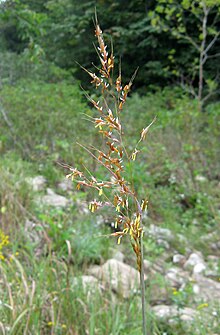
Sorghastrum nutans

| Sorghastrum nutans | |
|---|---|

| |
| Indiangrass in bloom | |
| Scientific classification | |
| Kingdom: | Plantae |
| Clade: | Tracheophytes |
| Clade: | Angiosperms |
| Clade: | Monocots |
| Clade: | Commelinids |
| Order: | Poales |
| Family: | Poaceae |
| Subfamily: | Panicoideae |
| Genus: | Sorghastrum |
| Species: | S. nutans
|
| Binomial name | |
| Sorghastrum nutans | |
| Synonyms[1] | |
| |
Sorghastrum nutans, known as Indiangrass,[2][3] is a North American prairie grass found in the United States and Canada, especially in the Great Plains and tallgrass prairies. It is sometimes called Indian grass[4], yellow Indian-grass,[2] or wood grass.[5]

Description
Indiangrass is a warm-season perennial bunchgrass.[6] It is intolerant to shade. It grows 3 to 7 feet (1 to 2 m) tall, and is distinguished by a "rifle-sight" ligule where the leaf blade attaches to the leaf sheath. The leaf is about 3 feet (1 m) long.[7]

It blooms from late summer to early fall, producing branched clusters (panicles) of spikelets. The spikelets are golden-brown during the blooming period, and each contain one perfect floret that has three large, showy yellow stamens and two feather-like stigmas. One of the two glumes at the base of the spikelets is covered in silky white hairs. The flowers are cross-pollinated by the wind.[8]

The branches of pollinated flower clusters bend outwards. At maturity, the seeds fall to the ground.[8] There are about 175,000 seeds per pound.[7]

-
Leaves in June
-
"Rifle-sight" ligule at the base of a leaf
-
Flowers with yellow stamens and golden-brown spikelets
-
Closeup of seeds
Ecology
Sorghastrum nutans is prominent in the tallgrass prairie ecosystem and the northern, central, and Flint Hills tall grassland ecoregions, along with the grasses big bluestem (Andropogon gerardi), little bluestem (Schizachyrium scoparium) and switchgrass (Panicum virgatum). It is also common in areas of longleaf pine.

Indiangrass is adapted in the United States from the southern border to Canada and from the eastern seaboard to Montana, Wyoming and Utah.[7]

It regrows with renewed vitality after fires, so controlled burns are used, replacing extirpated large herbivores (i.e. bison), for habitat renewal.

It is a larval host to the pepper-and-salt skipper.[9]

Culture
Indiangrass is the official state grass of both Oklahoma[10] and South Carolina.[11]

The USDA Natural Resources Conservation Service lists the following uses for Sorghastrum nutans: erosion control, livestock, pollinators, restoration, and wildlife.[7]

References
- ^ "Sorghastrum nutans". Germplasm Resources Information Network. Agricultural Research Service, United States Department of Agriculture. Retrieved 2011-03-03.
- ^ a b "Sorghastrum nutans". Integrated Taxonomic Information System. Retrieved 2024-10-16.
- ^ USDA, NRCS (n.d.). "Sorghastrum nutans". The PLANTS Database (plants.usda.gov). Greensboro, North Carolina: National Plant Data Team. Retrieved 16 October 2024.
- ^ Missouri Botanical Garden: Sorghastrum nutans — horticultural info.
- ^ "Sorghastrum nutans (L.) Nash GRIN-Global". npgsweb.ars-grin.gov. Retrieved 16 October 2024.
- ^ Floridata: Sorghastrum nutans
- ^ a b c d "Indiangrass." Plant Fact Sheet.2011. Accessed July 26, 2015
- ^ a b Hilty, John (2016). "Indian Grass (Sorghastrum nutans)". Illinois Wildflowers.
- ^ The Xerces Society (2016), Gardening for Butterflies: How You Can Attract and Protect Beautiful, Beneficial Insects, Timber Press.
- ^ "Oklahoma Symbols | Oklahoma Historical Society". Oklahoma Historical Society | OHS. Retrieved 16 October 2024.
- ^ "South Carolina State House | South Carolina State Symbols". www.scstatehouse.gov. Retrieved 16 October 2024.

- Andropogoneae
- Grasses of North America
- Bunchgrasses of North America
- Warm-season grasses of North America
- Grasses of the United States
- Grasses of Canada
- Native grasses of the Great Plains region
- Flora of the United States
- Flora of the Canadian Prairies
- Flora of the Western United States
- Flora of the Eastern United States
- Flora of Northern America
- Plants described in 1903
- Ornamental grass
See what we do next...
OR
By submitting your email or phone number, you're giving mschf permission to send you email and/or recurring marketing texts. Data rates may apply. Text stop to cancel, help for help.
Success: You're subscribed now !




